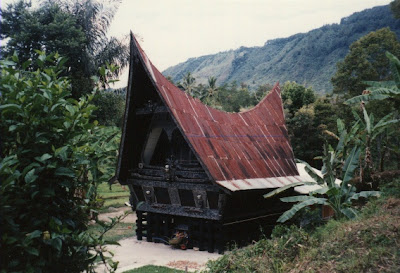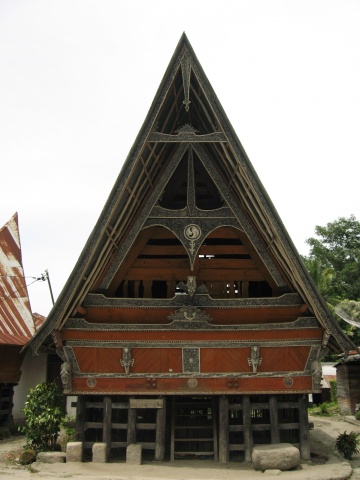
A Batak village, from Dwellings, Paul Oliver, 2003
The Bataks of North Sumatra were said to have practised ritual cannibalism. Marco Polo wrote in 13th century that inhabitants of that island ate their parents when they became too old for work; Raffles in the 19th century stated that for certain crimes a criminal would be eaten alive. According to a New York Times article, the eating of human flesh was always a highly formalized ritual, and the diners were picky - only outsiders, consenting old people and certain kinds of criminals were consumed.
Now the Bataks are mainly Christian: they were converted over a century ago.
“However, Batak Christianity can sometimes seem little more than nominal. You may, for instance, see the pastor beating on a drum for two days to ward off devils, or a church wedding followed by the traditional unjung ceremony, which unites clans by a ritual slaughtering of a water buffalo and a protracted communal bartering over a bride-price. The family and kin group remain the basic Batak social institutions and many aspects of their complex, pre- Christian forms of ancestor worship are still practiced”.

A Batak house, from www.travbuddy.com
The traditional, or adat-style, Batak houses can be large: up to 60 feet long and housing up to 12 families . They have distinctive saddle-backed, twin-peaked roof – like the horns of a buffalo - made from a special palm fibre and commonly anchored by long poles. But now they tend to be made from corrugated steel.

The front of the house, but where is the door? From www.travbuddy.com
Traditionally, Batak houses have no doors, but are entered by a ladder through a trapdoor in the raised floor. Inside it is dark because there are no windows!

Interior, from www.pbase.com
In some villages the houses are often built in two rows, the rumah or house facing south opposite the sopo facing north. In between is the halaman or plaza from where the grand houses can be admired.
References:
Related Posts: | Subscribe to Tessellar Blog and get a FREE E-Book
An Affordable Alternative to Terrace Housing 17MB, 49 A4 pages, 57 illustrations |

2 comments:
Why no windows? Weather related or cultural related.
I assume now days they do not munch to many elders and criminals. (Just outsiders) :)
Kyle
I really don't know why there's no windows: maybe they value their privacy.
I expect the issue of cannibalism will come up some more as we look at other islands in the South China Sea and the Pacific.
It's an interesting topic!
Post a Comment